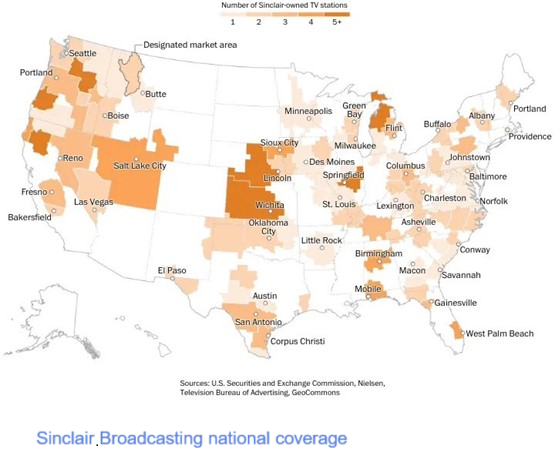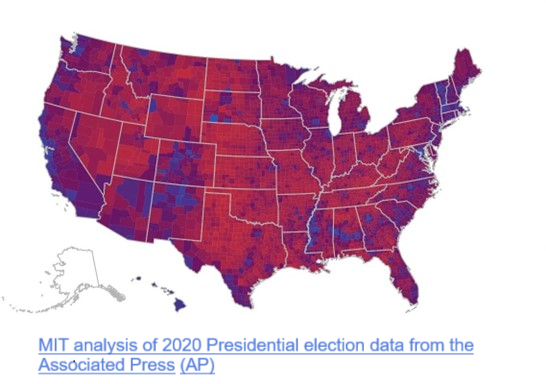Sinclair Broadcasting: All the News That Isn't

Donald Trump said he crushed it with Black journalists last week. You'd believe that too if you read the news story Sinclair sent to 40 percent of American households.
"What I tell you three times is true." The Bellman's announcement opening The Hunting of the Snark previews the nonsense to come in Lewis Carroll's classic comic poem about the search for a mythical beast. Sinclair Broadcasting might want to consider the line as the motto for its fiction factory producing the far-right fantasies its stations are forced to broadcast as news.
Sinclair owns 185 Fox, NBC, and ABC local TV stations, among others, as well as multicast and sports networks in 100 markets across the country. It's an impressive reach into 40 percent of America's households. But Sinclair's size isn't the issue. Combined with a right-wing spin on the national news, its penchant for pushing unsubstantiated stories -- from stolen elections and marauding migrants to Deep State conspiracies -- to its TV outlets is.
Sinclair's propaganda model would make Joe Stalin, or for that matter, Vladimir Putin, his 21st Century fanboy, smile. Housed at its headquarters, the National Desk produces and distributes hundreds of stories a month. For the local anchors that receive the copy, they're must- reads. Unfortunately, the effect isn't just displacing real news with agit-prop, though that's bad enough. It's poisoning the democratic process as well.
Two political scientists at Stanford and Emory universities who studied Sinclair in 2019 when they researched the relation between local news and national politics put it this way. "The rightward shift in content at Sinclair- acquired stations can…be expected to have real consequences for election outcomes and mass polarization." A half-decade later, an analytical gem by independent journalists writing last week on Substack.com underscores the professors' point.
Published on Substack's Popular Information, the article by Judd Legum and Rebecca Crosby exposes in detail the shoddy work produced by Sinclair's propaganda mill.
The authors examine Sinclair's "Rapid Response Team," a source on its National Desk of the required copy sent to its local stations. Their article documents the corporate unit's pro-Republican bias as well as multiple cockamamie claims in its news stories, ground out by the hundreds monthly and dispatched for mandatory air.
Take Sinclair's coverage of Donald Trump's bully boy blather at the annual conference of the National Association of Black Journalists last week. Sinclair's story is striking for its omissions: it faithfully recounts Trump's risible lines attacking his questioners and whining about his mistreatment, but omits any of the questions he dodged, the facts they presented, or the hoots from the audience his nonsensical answers provoked. Headlined by Trump's claim that he's been the best president for Blacks since Abe Lincoln, the so-called news piece would have done Josef Goebbels proud.
But the media giant's influence over what its TV news audiences see and know, or don't, isn't only because of the quality of its agitprop. It's magnified by a business model, a slash-and-burn cost-cutting approach at its stations, that has reduced local political news coverage and the independent insights that such journalism can bring. Sinclair's local reductions in force and their impact on grass roots reporting, of course, aren't the only downsizing underway. News deserts are growing as traditional newspapers continue to disappear at an alarming rate coast-to-coast.
Vanishing dailies aren't new or, unfortunately, news. According to Northwestern University Medill School of Journalism's State of Local News Project, last year 2.5 newspapers on average shut their doors each week. Of the 3143 counties in the United States, over half have either no local news source or only one remaining outlet, typically a weekly newspaper. Digital start-ups are bucking the trend, but most serve metropolitan areas, leaving news voids across the rural and small-town landscape that Sinclair's television outlets serve.
The coincidence of Sinclair Broadcasting's national footprint in rural areas and small towns and the growing news deserts outside major metropolitan areas is hard to miss.

To be sure, news consumers have a choice of networks and stations, but Sinclair's reach obviously ups its potential for political influence across rural and small-town America big time. Research by the Pew Center shows why. Even though Americans increasingly prefer to get local news online, television remains the go-to source for 32 percent of local news consumers. Two-thirds of those who cite TV as their local news source also say they watch their chosen outlets' daily news programming rather than seeking out local stations' stories on-line.
In 2024, there is admittedly a pearl-clutching quality to analysis that suggests partisan news coverage needs attention. Public opinion surveys as well as election polling adds evidence daily that voters have wedded themselves not only to their candidates of choice but also the news outlets that reinforce their own political views.
But the map below that reflects how the last presidential election turned out isn't just about the location of red and blue political real estate. Alongside Sinclair Broadcasting's reach and journalistic practices, it's about de facto information monopolies and their effect on what people understand -- the facts as well as the issues and what they mean for their choices.

"Propaganda doesn't deceive people. It merely helps people deceive themselves," the philosopher Eric Hoffer wrote 70 years ago. That said, it certainly helps the self-delusion along if the agitprop is all you can get when you tune in the six o'clock news.
This article was originally published at Substack.
Click the social buttons to share this story with colleagues and friends.
The opinions expressed here are the author's views and do not necessarily represent the views of MediaVillage.org/MyersBizNet.


